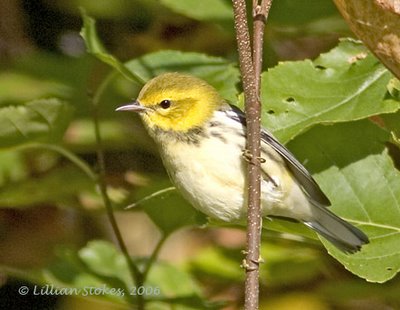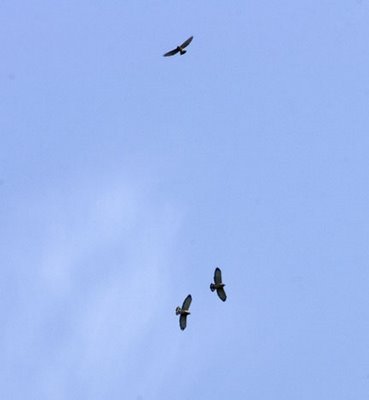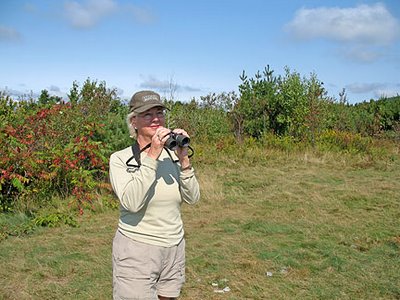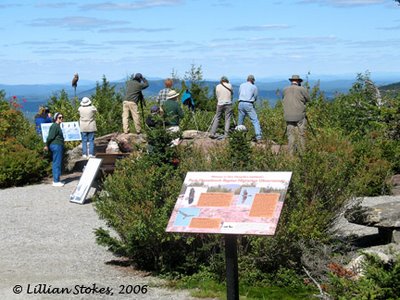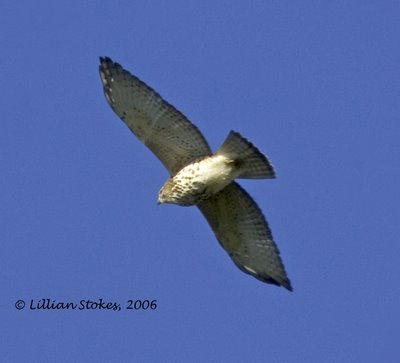This weekend is a good time to get out with your binoculars and Stokes Field Guide to Warblers and look for migrating warblers in a variety of places such as, parks, coastal areas, forest edges, even your own backyard. We will be looking too. Above are a few warblers that were in our yard yesterday.
All photos © Lillian Stokes, 2006
Saturday, September 30, 2006
Thursday, September 28, 2006
Northern Flicker
 While standing on our dock, I saw this Northern Flicker flying across the lake. Even though it was not close, I raised the camera to my eye and shot. I was thrilled to see I captured it with its wings up and the light shining on the beautiful gold underside of the wings. You can also see its telltale white rump. The subspecies of Northern Flicker found in the east, called "Yellow-shafted", has yellow underwings. The Subspecies of Norther Flicker found in the west, called Red-shafted" has reddish underwings.
While standing on our dock, I saw this Northern Flicker flying across the lake. Even though it was not close, I raised the camera to my eye and shot. I was thrilled to see I captured it with its wings up and the light shining on the beautiful gold underside of the wings. You can also see its telltale white rump. The subspecies of Northern Flicker found in the east, called "Yellow-shafted", has yellow underwings. The Subspecies of Norther Flicker found in the west, called Red-shafted" has reddish underwings.Photo © Lillian Stokes, 2006
Tuesday, September 26, 2006
Ivory-billed Woodpecker in Florida Panhandle
An international team of researchers from the University of Windsor in Ontario, Canada and Auburn University, Alabama, have announced they have sighted Ivory-billed Woodpeckers 14 times since May '05 in the Florida Panhandle along the Choctawhatchee River. There is a story on it today in the Toronto Star. The reasearchers have also just published a paper titled, Evidence Suggesting that Ivory-billed Woodpeckers (Campephilus principalis) Exist in Florida, in the Avian Conservation and Ecology Journal.
Ivory-bills were first seen on May 21, 2005 by Dr. Geoff Hill, an ornithologist from Auburn and his research assistants, Tyler Hicks and Brian Rolek. They say they got a clear view of the bird and heard its characteristic double knock sounds. A winter search began and they were joined by Dr. Dan Mennill, a sound monitoring specialist and assistant professor at the University of Windsor and Kyle Swiston, his graduate student. They collected acoustic evidence and say they had visual encounters, but, unfortunately, got no definitive photos.
Much more information is available at:
Dan Mennill's website, The Search for the Ivory-billed Woodpecker,
and Geoff Hill's website, Ivory-billed Woodpeckers in the Florida Panhandle which states:
"Although members of our search group are convinced that Ivory-billed Woodpeckers persist in the swamp forests along the Choctawhatchee River, we readily concede that the evidence we have amassed to date falls short of definitive. Definitive evidence will come in the form of a clear, indisputable film, digital image, or video image of an Ivory-billed Woodpecker or perhaps from a fresh feather or DNA sample."
The Choctawhatchee River Basin is in a rural area with few facilities, some inherent dangers (snakes, alligators, easy to get lost, etc.) and anyone searching would need topo maps and a GPS. Although the river basin is not closed to anyone, the researchers ask that birders not search in their area (which they are not disclosing, but will tell you to leave if you are in it) and not play any recordings of Ivory-billed Woodpeckers. They feel that Ivory-bills might be found widely along the Choctowhatchee River Basin and suggest searching in these other areas.
The Ivory-billed Woodpecker can be confused with the Pileated Woodpecker. We have posted 24 photos of Pileateds on our website to aid folks in Pileated identification,
on these two pages:
here,
and here.
Here are a few samples images of Pileated Woodpeckers from those pages:
Ivory-bills were first seen on May 21, 2005 by Dr. Geoff Hill, an ornithologist from Auburn and his research assistants, Tyler Hicks and Brian Rolek. They say they got a clear view of the bird and heard its characteristic double knock sounds. A winter search began and they were joined by Dr. Dan Mennill, a sound monitoring specialist and assistant professor at the University of Windsor and Kyle Swiston, his graduate student. They collected acoustic evidence and say they had visual encounters, but, unfortunately, got no definitive photos.
Much more information is available at:
Dan Mennill's website, The Search for the Ivory-billed Woodpecker,
and Geoff Hill's website, Ivory-billed Woodpeckers in the Florida Panhandle which states:
"Although members of our search group are convinced that Ivory-billed Woodpeckers persist in the swamp forests along the Choctawhatchee River, we readily concede that the evidence we have amassed to date falls short of definitive. Definitive evidence will come in the form of a clear, indisputable film, digital image, or video image of an Ivory-billed Woodpecker or perhaps from a fresh feather or DNA sample."
The Choctawhatchee River Basin is in a rural area with few facilities, some inherent dangers (snakes, alligators, easy to get lost, etc.) and anyone searching would need topo maps and a GPS. Although the river basin is not closed to anyone, the researchers ask that birders not search in their area (which they are not disclosing, but will tell you to leave if you are in it) and not play any recordings of Ivory-billed Woodpeckers. They feel that Ivory-bills might be found widely along the Choctowhatchee River Basin and suggest searching in these other areas.
The Ivory-billed Woodpecker can be confused with the Pileated Woodpecker. We have posted 24 photos of Pileateds on our website to aid folks in Pileated identification,
on these two pages:
here,
and here.
Here are a few samples images of Pileated Woodpeckers from those pages:
Sunday, September 24, 2006
Seedy Story
 The American Goldfinches are loving the seeds in our garden. Here's a male eating the seeds of Purple Coneflower. We notice he looks a little ratty. That's because he is beginning to molt from his worn breeding plumage into his more subdued winter plumage. Time to change clothes.
The American Goldfinches are loving the seeds in our garden. Here's a male eating the seeds of Purple Coneflower. We notice he looks a little ratty. That's because he is beginning to molt from his worn breeding plumage into his more subdued winter plumage. Time to change clothes.Many people write to us this time of year and wonder where all the birds have gone from their feeders. We know where our birds are. Like this male goldfinch, they are chowing down on nature's ample fall banquet of all the seeds and nuts that are available this time of year.
Photo © Lillian Stokes, 2006
Friday, September 22, 2006
Moose Haiku
 Drinking our coffee
Drinking our coffeeA dew-clad Moose walks by us
His mind on the wild
Really, we were just sitting on our deck in the morning, drinking coffee and this large Bull Moose walked by within 35 feet of us! He seems not to care about us, his mind on other things (probably looking for a female), as we sat there speechless. He wandered down into our large hayfield that had just been cut and baled. That's what we love about our "Bobolink Farm" property, we just never know what cool thing is going to happen. There are always surprises.
Photo © Lillian Stokes, 2006
Photo © Lillian Stokes, 2006
Wednesday, September 20, 2006
Freedom: Broad-winged Hawk







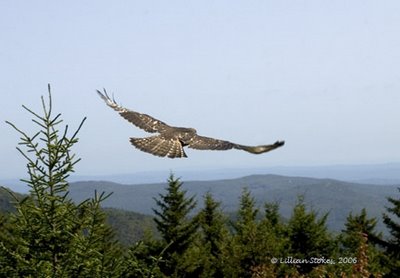 The hawkwatch event on Sunday at New Hampshire Audubon's Pack Monadnock Raptor Migration Observatory attracted quite a number of folks, from young to old, who came to see a release into the wild of some rehabilitated hawks. The new president of New Hampshire Audubon, Rick Minard, welcomed the enthusiastic crowd. One of the birds to be released was this Broad-winged Hawk. Julie, the site's official counter, held up the bird, as a hushed crowd watched. She pivoted, then released her grip and this young raptor, raised from a nestling by a skilled bird rehabilitator, experienced its destiny — to live free and wild.
The hawkwatch event on Sunday at New Hampshire Audubon's Pack Monadnock Raptor Migration Observatory attracted quite a number of folks, from young to old, who came to see a release into the wild of some rehabilitated hawks. The new president of New Hampshire Audubon, Rick Minard, welcomed the enthusiastic crowd. One of the birds to be released was this Broad-winged Hawk. Julie, the site's official counter, held up the bird, as a hushed crowd watched. She pivoted, then released her grip and this young raptor, raised from a nestling by a skilled bird rehabilitator, experienced its destiny — to live free and wild.All photos © Lillian Stokes, 2006
Saturday, September 16, 2006
...and More Hawkwatching
 This Immature Broad-winged Hawk has multiple thin dark bands on tail, the adult has just a few broad black and white bands on tail.
This Immature Broad-winged Hawk has multiple thin dark bands on tail, the adult has just a few broad black and white bands on tail.Thursday, September 14, 2006
Merlin: The Chocolate Falcon
 We continued hawkwatching on Tuesday and even though there were fewer hawks than our record-breaking day, we had some fun birds. This Merlin flew close enough to the hawkwatch site to allow me to grab my camera and shoot.
We continued hawkwatching on Tuesday and even though there were fewer hawks than our record-breaking day, we had some fun birds. This Merlin flew close enough to the hawkwatch site to allow me to grab my camera and shoot.Merlins always quicken my pluse as they fly by. They'e a falcon who means business. A swift, powerful, focused flyer, they're a thrill to watch. Female and immature Merlins are dark above, dark streaked below, hence the term "chocolate falcon". Males are blue-gray above, streaked below.
Tuesday, September 12, 2006
Record-breaking Hawkwatch Day
 A "kettle" (group) of Broad-winged Hawks rising on a thermal. Some were so far away they looked this tiny through binoculars. Often they could only be seen through scopes.
A "kettle" (group) of Broad-winged Hawks rising on a thermal. Some were so far away they looked this tiny through binoculars. Often they could only be seen through scopes. An American Kestrel flies close. Notice the pointed wings and long tail. We identify hawks at a distance by their shape and flight behavior.
An American Kestrel flies close. Notice the pointed wings and long tail. We identify hawks at a distance by their shape and flight behavior.Monday, September 11, 2006
Gone Hawkwatching
 We are going hawkwatching today and any day this week that seems promising. So we will get to the blog when we can. Yesterday we watched from our property, Bobolink Farm, and saw 376 hawks, most seen from 3:00- 5:30 pm. The majority of them were Broad-winged Hawks and we also saw 2 Bald Eagles, very exciting!
We are going hawkwatching today and any day this week that seems promising. So we will get to the blog when we can. Yesterday we watched from our property, Bobolink Farm, and saw 376 hawks, most seen from 3:00- 5:30 pm. The majority of them were Broad-winged Hawks and we also saw 2 Bald Eagles, very exciting!Traditionally, most Broad-winged Hawks clear out of New England between Sept. 10th and 20th. They migrate using thermals, rising up, then gliding to the next. So when a Canadian high pressure system moves through, as is occurring now, it brings thermals, mild northerly winds, and ideal hawk migrating conditions. We grab our "Stokes DLS" 8 power binoculars (best power for hawkwatching), pack a lunch and off we go to a hawkwatch site. If you have time today, or any clear day this week, and are in the eastern part of the country, look up, you may see some hawks.
Saturday, September 09, 2006
Monarch Butterfly Migration

 Monarch Butterflies are migrating big-time through our property right now. It makes us so glad that our garden is planted with loads of butterfly-attracting flowers. We counted 14 Monarchs in the garden yesterday as we sat and ate our lunch on the garden bench. Very magical. Made us feel like we were in a butterfly house. The male Monarch, shown in above photo, can be told by the little black dot ( called stigmata) on the vein of each hindwing.
Monarch Butterflies are migrating big-time through our property right now. It makes us so glad that our garden is planted with loads of butterfly-attracting flowers. We counted 14 Monarchs in the garden yesterday as we sat and ate our lunch on the garden bench. Very magical. Made us feel like we were in a butterfly house. The male Monarch, shown in above photo, can be told by the little black dot ( called stigmata) on the vein of each hindwing.Monarchs migrate to the center of Mexico and overwinter. They come back to southern areas of the U.S. in spring and lay eggs and those offspring are the ones who continue the journey northward. The last generation of Monarchs born in the autumn are special. They are the longest lived and the ones that migrate to Mexico in winter. And so the cycle continues again each year.
Wednesday, September 06, 2006
Western Reef-Heron continues
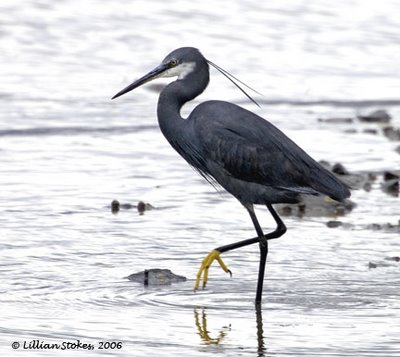 The Western Reef-Heron, the rare bird that has only been seen 3 times before in North America (once before in the U.S.), is continuing in NH. It was seen on Monday from 2:00 to 4:00 pm at low tide on the flats viewed from Clough Court off South St. that runs between Rt. 1A and 1B in Portsmouth, NH. Hundreds of birders from many areas of the country, even Alaska, have come to see it. If you want to see it, look at the New Hampshire Birds listserv for the latest updates. It may not stay around that much longer, as fall is here, and it may migrate to??? Basically, we do not know where this bird came from or where it is going to.
The Western Reef-Heron, the rare bird that has only been seen 3 times before in North America (once before in the U.S.), is continuing in NH. It was seen on Monday from 2:00 to 4:00 pm at low tide on the flats viewed from Clough Court off South St. that runs between Rt. 1A and 1B in Portsmouth, NH. Hundreds of birders from many areas of the country, even Alaska, have come to see it. If you want to see it, look at the New Hampshire Birds listserv for the latest updates. It may not stay around that much longer, as fall is here, and it may migrate to??? Basically, we do not know where this bird came from or where it is going to.There was a Western-Reef Heron report from Stephenville Crossing, Newfoundland in 2005. That bird stayed for the summer, lingered through the first week of Sept. then left.
This year, a Western-Reef Heron was discovered in Big Glace Bay Lake, Nova Scotia on June 26th, and it may have been there as early as May. That bird was seen until August 2nd. then disappeared.
On August 18th this year a Western-Reef Heron showed up in Kittery, Maine and this bird (which I have photographed) is the one that has divided it's time between Maine and NH, most recently just in NH, and has delighted so many birders. (Note, the only other North American record of a Western Reef-Heron was in 1983 in Nantucket, MA.)
So many questions remain. Are the 2005 and all the 2006 sightings all of the same bird? Where did the bird come from in the first place? How long will it stay this year? Where will it go next? Is there some special wintering place it goes to in this hemisphere, that no one has yet discovered? Hmmm, maybe we should all be checking out the herons in Florida this winter, maybe its hanging out with the Snowys and Tri-colored Herons there. Or maybe it winters in Barbados or elsewhere in the Carribean.
And, of course, one of the biggest questions is, is it a Western Reef-Heron in the first place, or maybe a dark morph Little Egret, as current research suggests. There are some fascinating behavioral observations on the Western Reef-Heron seen in Newfoundland in 2005. That bird was seen in the company of a Little Egret (another rarity there at the same time.) The two birds were seen frequently feeding together and often the bird identified as the Western Reef-Heron would pick up twigs or sticks and present them to the Little Egret!
Now that's awfully friendly for birds that are considered two separate species. That type of behavior usually occurs between mated pairs of herons. For example, Parsons, K.C. and T. L. Master. 2000. In The Birds of North America, No. 489 (A. Poole and F. Gill, eds). The Birds of North America, Inc., Philadelphia, PA., an authoritative monograph on Snowy Egret, notes that the "male supplies nesting material while the female works sticks into the nest" and the "nest relief ceremony is often accompanied by offering nest material."
As they say, the whole thing gets "curiouser and curiouser". Stay tuned.
Photo © Lillian Stokes, 2006
Tuesday, September 05, 2006
Sunflowers for Birds

 We love the tall sunflowers that are blooming now in our garden. Some we have planted and some, including the ones in these photos, have popped up from seed left in the ground from last year's batch. Not only are they cheery, but they are a serendipitous bounty for the birds. We cut some for vases to decorate our house. Most we leave for the birds who come and eat the seeds as they mature. The goldfinches have already discovered them and fly up as we walk by.
We love the tall sunflowers that are blooming now in our garden. Some we have planted and some, including the ones in these photos, have popped up from seed left in the ground from last year's batch. Not only are they cheery, but they are a serendipitous bounty for the birds. We cut some for vases to decorate our house. Most we leave for the birds who come and eat the seeds as they mature. The goldfinches have already discovered them and fly up as we walk by.
Saturday, September 02, 2006
Great Spangled Fritillary Butterfly
 Our butterfly bushes (Buddleia davidii) are in full bloom right now in our garden and they're magnets for the butterflies. Here's a Great Spangled Fritillary butterfly on one of them. This plant is on the path from our driveway to our house, so each time we walk by it, we're treated to its sweet fragrance and the beauty of butterflies.
Our butterfly bushes (Buddleia davidii) are in full bloom right now in our garden and they're magnets for the butterflies. Here's a Great Spangled Fritillary butterfly on one of them. This plant is on the path from our driveway to our house, so each time we walk by it, we're treated to its sweet fragrance and the beauty of butterflies.
